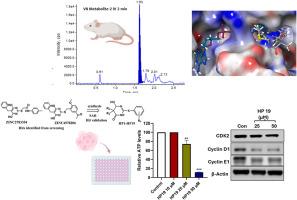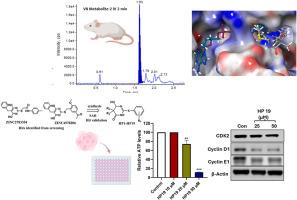Synthesis, molecular modeling, biological and pharmacokinetic evaluation of hydroxy pyrimidinones and pyrimidinediones as novel LDHA inhibitors
IF 5.9
2区 医学
Q1 CHEMISTRY, MEDICINAL
引用次数: 0
Abstract
There is compelling evidence that increased LDHA expression and lactate accumulation promote tumor progression, particularly in patients with basal/quasi-mesenchymal (QM) tumor subtypes that exhibit a glycolytic phenotype. Despite efforts to develop small-molecule inhibitors, no LDHA inhibitor is currently available in the clinic, and advancing new chemical space is needed. In our earlier studies, we identified hits, containing a novel hydroxy pyrimidinone motif, including ZINC2783354 and ZINC4978206, against LDHA. In this study, we performed pharmacokinetic evaluation and in vivo metabolic profiling of our starting hit to inform the design of new analogs, leading to the identification of pyrimidinedione as a new chemotype with LDHA inhibitory activity. The most promising compound, HP19, inhibited LDHA with IC50 of 5.2 μM, demonstrated lactate inhibition, and reduced H3K18 lactylation. HP19 resulted in a drastic reduction in ATP levels and inhibited proliferation of PANC-1 cells with IC50 of 22.7 μM. The antiproliferative effects of HP19 in PANC-1 cells were mediated by G1/S cell cycle arrest and induction of apoptosis.


新型LDHA抑制剂羟基嘧啶和嘧啶二酮的合成、分子模拟、生物学和药代动力学评价
有令人信服的证据表明,增加的LDHA表达和乳酸积累促进肿瘤进展,特别是在表现出糖酵解表型的基底/准间充质(QM)肿瘤亚型患者中。尽管人们努力开发小分子抑制剂,但目前临床上还没有可用的LDHA抑制剂,因此需要推进新的化学领域。在我们早期的研究中,我们发现了含有新型羟基嘧啶基序的命中点,包括ZINC2783354和ZINC4978206,可以对抗LDHA。在本研究中,我们对起始靶点进行了药代动力学评估和体内代谢分析,为新的类似物的设计提供信息,从而鉴定出嘧啶二酮是一种具有LDHA抑制活性的新化学型。最有希望的化合物HP19抑制LDHA的IC50为5.2 μM,表现出乳酸抑制作用,并降低H3K18的乳酸化。HP19显著降低ATP水平,抑制PANC-1细胞增殖,IC50为22.7 μM。HP19在PANC-1细胞中的抗增殖作用是通过阻滞G1/S细胞周期和诱导凋亡介导的。
本文章由计算机程序翻译,如有差异,请以英文原文为准。
求助全文
约1分钟内获得全文
求助全文
来源期刊
CiteScore
11.70
自引率
9.00%
发文量
863
审稿时长
29 days
期刊介绍:
The European Journal of Medicinal Chemistry is a global journal that publishes studies on all aspects of medicinal chemistry. It provides a medium for publication of original papers and also welcomes critical review papers.
A typical paper would report on the organic synthesis, characterization and pharmacological evaluation of compounds. Other topics of interest are drug design, QSAR, molecular modeling, drug-receptor interactions, molecular aspects of drug metabolism, prodrug synthesis and drug targeting. The journal expects manuscripts to present the rational for a study, provide insight into the design of compounds or understanding of mechanism, or clarify the targets.

 求助内容:
求助内容: 应助结果提醒方式:
应助结果提醒方式:


